Every woman has experienced acne on her body at least once. Some are actively searching for an effective remedy, while others consider squeezing to be the only way to fight.
But few people ask themselves the question: why do rashes appear and what types are they divided into?
Varieties
Depending on the cause and nature of the disease, acne is divided into several groups.
Pustule
The pimple is inflammatory in nature, the cavity of which is filled with pus. Externally, the pustule looks like a small ball surrounded by inflamed skin.
After a large amount of liquid accumulates in the cavity, the formation ruptures, after which it becomes covered with a crust.
Depending on the location on human skin, pustular elements are divided into two groups:
- An epidermal pustule is located on the surface of the skin. More often than not, acne breaks out on its own, which eliminates the appearance of scars and cicatrices.
- A dermal pustule can be distinguished by its location: subcutaneous tissue. After the pustular rash heals, age spots, scars and irregularities remain on the skin.
Pimples can appear directly in the hair follicle and outside it. The treatment process and its duration largely depend on this.
Lightning fast
To date, the exact cause of acne fulminans has not been established. The disease is most often diagnosed as a symptom of nodular cystic or papulopustular acne.
A distinctive feature of fulminant acne is the rapid appearance of a rash of an ulcerative-necrotic nature.
The patient may notice a deterioration in health, which is manifested by increased body temperature, pain in muscles and joints.
Video: Causes of rashes on the face in women
Nodular-cystic
The most common form of acne in adolescence, which manifests itself as deep infiltrative elements on the face filled with pus.
Acne of this type is nothing more than an inflammatory process in the sebaceous glands. Their occurrence occurs with the progression of seborrheic dermatitis, which is characterized by the release of large amounts of sebum.
The thick secretion in the gland causes the rapid proliferation of bacteria that penetrate from the surface of the skin. The inflammatory process spreads not only in the epidermis, but also in the deeper layers of the dermis. This leads to scarring on the skin after nodular cystic acne resolves.
Comedo
Acne occurs due to a malfunction of the hormonal and regulatory functioning of the sebaceous glands. This is manifested by increased secretion of sebum with a low concentration of linoleic acid, which is part of the cell membrane.
Comedones are divided into two groups:
- Open ones are characterized by the accumulation of not only a large amount of fat, but also dead epidermal cells, dust particles and decorative cosmetics. As a result, the hair follicle becomes clogged and a black dot appears on the surface.
- Closed comedones are located under the skin and do not reach the surface. Outwardly, they look like white balls or nodules that rise above the surface of the skin. All this leads to the creation of a favorable environment for the proliferation of fungi and bacteria.
In closed pimples and the tissues around them, inflammation begins, and pain appears with slight pressure. Lack of proper treatment can lead to the development of an abscess or boils. Once the acne resolves, noticeable scars remain.
Causes of acne on the face in women
Acne and pimples most often appear on the skin of teenagers when hormonal imbalance begins. But the rash can appear in women even after thirty years of age. Their reasons can be varied. The disease requires immediate diagnosis and proper treatment.
Hormonal disorders
Most often, acne occurs against the background of gynecological and endocrine problems, which are the causes of hormonal disorders.
This leads to the fact that the sebaceous glands begin to produce a more viscous secretion. The pores become clogged over time, and when fungus enters from the external environment, an inflamed pimple appears.
If after thirty, acne begins to appear intensively on the skin, a visit to the gynecologist and endocrinologist should not be postponed. The rash can be triggered by polycystic ovary syndrome, malfunction of the pituitary gland, or adrenal dysfunction. These diseases lead to hormonal imbalance in the body.
Pregnancy from the first days, regardless of the woman’s age, leads to dramatic changes in the functioning of the endocrine system. Therefore, acne at this moment is normal.
Hormonal changes in the body can be caused by contraception, sudden changes in climatic conditions, lack of personal hygiene or any gynecological interventions.
Stress
Stressful situations can be chronic or sudden. In the second case, the effect on the skin is stronger, but in the first, acne goes away much faster. Constant disorders and experiences lead to thinning of the upper layer of the epidermis and the appearance of microcracks.
Menstrual irregularities
Before the onset of menstruation, the concentration of androgens increases, which leads to an increase in subcutaneous sebum. The cell walls of the spore become thinner and begin to collapse, due to which the inflammatory process begins.
Acne after the end of the menstrual cycle goes away on its own over time, when the concentration of hormones in the body is restored.
But gynecological diseases can often occur with changes in the hormonal levels of the body. It is for this reason that rashes can become chronic.
Recipe for acne remedies at home. More details here.
Climax
The menopausal period, depending on the characteristics of the body, begins after forty-eight years.
The attenuation of a woman’s reproductive system depends on hereditary factors, psychological state, pathology of the endocrine system or a large number of abortions.
When the body undergoes restructuring, the amount of female hormones decreases significantly. This factor affects the condition of a woman’s skin.
Testosterone, which replaces estrogen over time, causes the skin to become less elastic and subcutaneous capillaries become more visible.
Over time, a woman's skin becomes dry. To eliminate this problem, the sebaceous glands begin to produce a lot of subcutaneous sebum.
It, in turn, coming out, connects with dead cells of the epidermis, creating favorable conditions for infection.
During menopause, the rash is denser and deeper. It is localized around the mouth, chin or neck in the form of small red rashes.
Pregnancy
After fertilization of an egg in a woman’s body, the amount of progesterone in the body increases. It, in turn, affects the abundant secretion of subcutaneous fat.
The largest number of acne can be noted on the skin of the face, neck and shoulders, which most often go away after the first trimester on their own.
Allergy
An allergic rash can be caused by low-quality cosmetics, synthetics, washing powders or food. Small red pimples filled with clear liquid can be located on a woman’s face, arms and body.
Diet
The human digestive system directly affects the functioning of the entire body. Poor nutrition results in insufficient nutrients and an inability to remove harmful substances through the pores of the skin.
Acne is caused by:
- strong coffee;
- sweet and flour products;
- animal fats;
- various cheeses.
For beautiful and healthy skin, you need to include fermented milk products, fresh vegetables and fruits, herbs and fish in your daily diet.
Bad habits
Alcoholic drinks and tobacco products lower immunity and affect the structure of the skin. It becomes thin, more susceptible to various damage and inflammation. You can only get rid of acne by giving up bad habits.
For girls (14-20 years old)
From the beginning of adolescence, due to hormonal changes in the body, acne begins to appear on the face of girls. But not only this can cause rashes.
Oily skin
This type of skin is characterized by a large amount of secretion produced by the glands. The pores on the skin will expand, making them more visible and susceptible to infection.
Inflammatory process
Any, even minor, damage to the skin provokes the penetration of microbes or fungi into the deep layers of the epidermis. As a result, an inflammatory process begins in the pores, which leads to the appearance of pustules.
Bacteria and dirt
In the absence of personal hygiene and enlarged pores, bacteria begin to multiply intensively on a girl’s face. When it enters the layers of the epidermis, inflammation begins, which is accompanied by the accumulation of pus.
Contaminated with dead cells
Dead epidermal cells along with dust particles can penetrate the pores of the skin. The body responds to the penetration of a foreign body with an inflammatory process, resulting in boils and blackheads.
Treatment options
Acne treatment is a long process. Depending on the cause, area of damage and concomitant diseases, traditional medicine or drugs are used.
Prevention
- Personal hygiene is the key to healthy skin. For washing, you need to find an effective product that needs to be used daily.
- To prevent the appearance of acne, it is recommended to regularly cleanse your face under the supervision of cosmetologists.
- Proper nutrition, exercise and frequent walks in the fresh air also play a big role in maintaining healthy skin.
- Protects skin from bad weather conditions and prolonged exposure to the sun.
Medications
The advantage of ointments is their powerful effect on the pathogen. In addition, they are able to penetrate even into the deep layers of the epidermis without losing their pharmacological properties.
The most common medications include sulfuric ointment, synthomycin ointment, and Zinerit. Each of them has its own contraindications, so before use you need to carefully study the instructions.
Cosmetology products
Very often, ointments and gels for acne do not have the desired effect.
In this case, you should contact a cosmetologist.
- Chemical peeling is based on the application of a special acid to damaged areas. After a few minutes, it is removed with clean water or soda solution.
- Ultrasonic peeling promotes deep cleansing of pores, removing dead particles of the epidermis. At the same time, a massage is performed to improve blood circulation.
Any cosmetic procedures have contraindications, so in some cases their implementation is inappropriate.
ethnoscience
At home, you can use masks, lotions and baths based on calendula, aloe juice, sea salt, fresh apple, cucumber. They help cleanse pores, relieve pain and inflammation.
Acne on the face of women is not only a cosmetic problem, but also a sign of health problems, sometimes very serious. Therefore, treatment of facial acne in women should be carried out comprehensively using local and general remedies, as well as following the rules of facial skin care.
Causes of acne
The causes of acne on the face in women are a combination of several factors. First of all, there is excess production of sebum, so acne on women’s faces often occurs with oily dermis. The next link in the pathogenesis is blockage of the ducts of the sebaceous glands with an excessive amount of secretion and the formation of so-called blackheads, most often on the lower part of the face. When an infection occurs, including normal skin microorganisms, inflammation occurs and acne appears on the face of women.
Factors that trigger the pathological process may be:
- Hormonal imbalance (puberty, pregnancy, menopause, endocrine diseases);
- Immune system disorders (including diabetes mellitus);
- Excess weight and poor nutrition also take their place among the causes of facial acne in women;
- The influence of toxic substances - occupational hazards, unfavorable environmental conditions;
- Improper skin care;
- Other causes of acne on the face in women.
Most often, there is either a combination of several factors or serious health problems, where acne on the face is the lesser of the evils. In addition, rashes associated with infectious or allergic diseases are often mistaken for acne.
In dermatology, there are several types of rashes on the face and neck, each of which has its own causes and treatment features. The most harmless are open comedones (blackheads), which appear when the sebaceous glands are blocked without inflammation. Closed comedones or whiteheads are a kind of subcutaneous pimples. The blockage is located deep under the skin, at the base of the excretory duct, and large fatty deposits appear on the surface - most often this happens with hormonal imbalances. Both of these types of acne are non-inflammatory manifestations of acne in adult women and teenage girls.
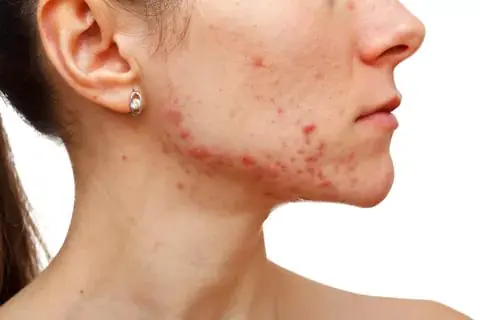
Inflamed rashes along the contour of the face are formed if an infection gets into the blocked duct. This is not difficult to do, so acne on the face of an adult woman quickly passes into the inflammatory stage.
A papule is a small nodule, slightly raised above the surface of the skin, bright red in color, painful with strong pressure, characteristic of any age - from teenagers to women over 45. A more complex formation is a pustule, abscess. It differs from a papule in its larger size and more pronounced pain, although the causes of red pimples are very similar. If you crush the papule, a small amount of pus is released.
In addition, a clinical classification has been adopted for the causes of facial acne in women of reproductive age, adolescents and girls, which examines in detail more than 20 types of acne.
Before wondering how to treat acne on the face of women, it is important to learn to distinguish them from rashes caused by serious diseases of connective tissue, immunity, and inflammatory skin pathologies. One of the main signs is that the dermis around acne is not involved in the inflammatory process, it remains healthy and has a normal appearance.
Nutrition and lifestyle for acne
Having understood why acne occurs, it becomes obvious that the problem must be solved comprehensively. Many representatives of the fairer sex, especially adults, think that they know how to eat properly, and their diet has absolutely nothing to do with dermatological problems. This is not so - an excess of fatty foods and a lack of vitamins leads to disruption of the sebaceous glands. In addition, gastrointestinal diseases impair the absorption of nutrients.
The first thing you need to do to treat facial acne in adult women is to review your diet. And not only for those who eat irrationally, but also for athletes on fat-free diets.
Vitamins necessary for the skin (A and E) are fat-soluble, and the body can only absorb them together with fats. Vegetable oils are best suited for this. But animal fats should really be excluded from the diet if possible.
If the patient suffers from any diseases of the stomach or intestines, she needs to follow a particularly strict diet.
Before treating acne on the face of a woman with digestive disorders, you need to contact a nutritionist who will help you create a therapeutic diet with a selection of products.
Facial skin care
Without a doubt, facial skin care is a key link in eliminating acne, especially for mature women over 40. A cosmetologist will help you choose the right care system, but you can even independently assess the type of your dermis and understand what it needs.
If acne appears on the face, the cause in women is often considered to be oily skin. But the trouble is that the dermis can become oily, paradoxically, from lack of nutrition and hydration. The pathogenesis chain here is quite simple - there is not enough hydration - the skin produces more sebum - acne appears. Therefore, it is necessary to regularly use moisturizing and nourishing creams to normalize sebum production.
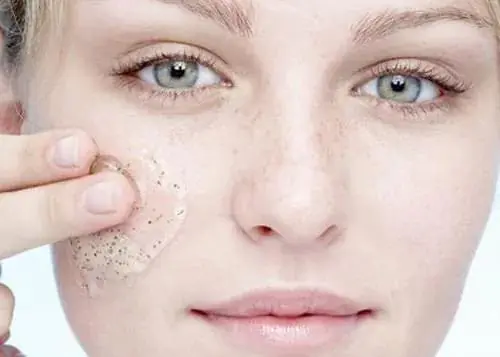
To get rid of sebaceous plugs, which are the main reason why acne occurs, you should use scrubs for deep cleansing of the skin, gels for washing against blackheads and other products that eliminate blockage of the ducts of the sebaceous glands.
Since the main cause of purulent acne is infection, care should be taken to eliminate it. In this case, local antiseptics that are gentle on the skin are preferred - miramistin, chlorhegsidine. You should refrain from alcohol solutions and hydrogen peroxide - they dry the skin, causing increased sebum production.
Local antiseptics and scrubs should be applied to clean and dry skin, and gels should be used while washing. Antibacterial soap does not cope well with acne, so it makes no sense to consider it as a remedy.
Drug treatment
If acne stubbornly does not go away with a review of your diet and lifestyle, and proper facial care, it is likely that it means a serious disease of the endocrine, digestive or immune system. In this case, you need to stop self-medication and consult a doctor to prescribe treatment for the underlying disease.
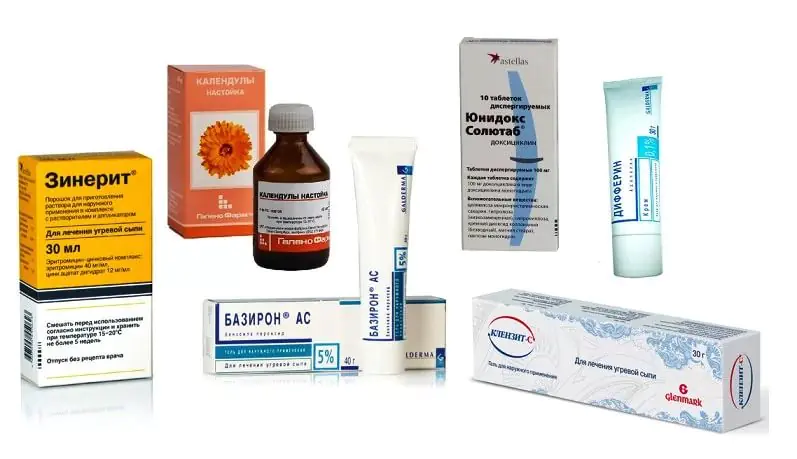
To combat acne itself, various medications can be prescribed. First of all, these are vitamins A and E in capsules or the drug Aevit. Fat-soluble vitamins maintain skin health, normalize sebum production, and ensure normal hydration and nutrition of the facial skin. In addition, immunomodulatory drugs, anti-inflammatory drugs and antibiotics may be prescribed.
People over 30 should pay special attention to the condition of their dermis in order to prevent problems with it in the future. This will be helped by preventative courses of vitamins and immunomodulators (as prescribed by a doctor!), procedures to maintain youthful and fresh skin, and a healthy lifestyle. All this will help slow down the withering.
Conclusion
The causes of acne on the face in women can be varied, and before starting treatment, the provoking factor should be determined. They need to be dealt with comprehensively - eliminating not only the skin symptoms themselves, but also the possible pathologies that lead to their occurrence. Sometimes you have to radically change your lifestyle for the sake of beautiful skin - unhealthy diet, stress and bad habits are detrimental to beauty.
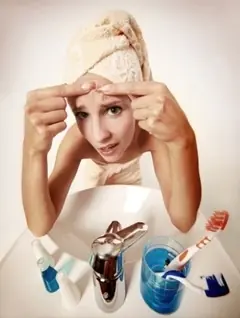
In the fight against acne, the initial task is to find out the causes of their occurrence.

If you suffer from acne, it is recommended to visit an endocrinologist and check your hormonal levels.

In some cases, acne may be the result of an allergic reaction.
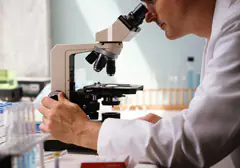
Demodicosis is a disease caused by the microscopic Demodex mite, which can cause progressive acne and pimples.

Acne often occurs in people suffering from intestinal dysbiosis.

Weakened immunity sets the stage for various ailments that can cause, including acne.
Morning, you set the coffee to brew and rush to the bathroom for a morning shower. The day promises to be wonderful, long and full of meetings and discoveries. However, one look in the mirror and the good mood disappears... Acne, or acne, this scourge of youth, grows older every year. And now, even at 40 years old, no one is protected from it. However, let's understand the causes of acne and the means to combat acne.
City air, consumption of fast food and other factors significantly prolong the period of activity of the sebaceous glands and expose the skin to additional stress, which makes this disease a disease of all ages. However, undoubtedly, it is the teenage and post-adolescent periods of hormonal “bursts”, the beginning of which is signaled by the appearance of acne, that are distinguished by the most active manifestation of this skin disease of the face, and sometimes the body.
Causes of acne on the face, types of acne
So, the most common cause of acne on the face is hormonal changes in the body. Of course, adolescence is the most striking example of this. In a person’s life, this is the period of greatest hormonal activity. A hormonal storm rages inside the body, and outside we see its consequences - a roughening voice, changing body proportions and, alas, acne. Few people manage to avoid this scourge - teenage acne. Even if growing up is normal and the skin is quite thin and problem-free, it is impossible to go through puberty without a single pimple - they will appear, even if only in single quantities.
Similar work of the hormonal glands also occurs in women during pregnancy and a certain phase of the menstrual cycle (and this can also be accompanied in some cases by acne) or with certain endocrine problems in adults. Even newborn babies exhibit conditions similar to acne - they also have a hormonal nature, even a separate name - hormonal crisis. In addition, some medications, specifics of work, even inhaled air - all this can become a pathogenic factor for acne.
Actually, the word pimple is not exactly a medical term, or rather, its meaning is too vague. Experts distinguish the following types of acne:
- Comedo. This is not even a pimple, but a “pre-pimple” or a so-called white pimple. A comedon is a sebaceous plug that clogs a pore, causing future inflammation. In everyday life, comedones are also called “blackheads”; black color is the color of oxidized sebum on the surface of the comedones. If a plug has formed in the upper part of the pore, this is an open comedon; on the surface of the skin it appears as an easily removable tubercle filled with liquid. A closed comedon is, accordingly, localized deeper in the pore. On the skin it appears as a dense white ball, a wen. If such a comedone gets infected, a papule develops.
- Papule. This is already a full-fledged pimple, it is inflamed and painful on palpation, which is why its color can vary from red to bluish. When pressed, it turns pale, then becomes filled with blood again.
- Pustule. May be primary. Capable of emerging from a papule. It differs from the latter in the presence of purulent contents, which emerge on the surface of the pimple as a white dot. Papules and pustules have the common name “red pimples.”
- Nodular cystic acne. Severe form of pustules, which are no longer single, but form conglomerates penetrating deep into the dermis; they are connected by fistulous ducts and are quite painful. They require serious systemic treatment.
- Lightning acne. The most severe form of acne is accompanied not only by large areas of acne, but also by hyperthermia, muscle and bone pain, and changes in the leukocyte formula of the blood. Requires immediate medical attention.
Depending on the type of rash, there are four degrees of acne severity:
- First degree. A local area of the face is affected (for example, the forehead or chin). Rashes in the form of comedones, occasionally papules and pustules.
- Second degree. It differs from the first degree quantitatively - a large surface of the face is affected, there are rashes on the body. The qualitative composition of acne is the same as in the first level disease - comedones, single papules and pustules.
- Third degree. In addition to comedones, there are many papules and pustules, the inflammatory process is pronounced, and hyperemia (redness, itching) of the skin is possible. Traces of acne.
- Fourth degree, the heaviest. Large spherical pimples (more than 5 mm), bluish-red in color, penetrate deep into the layers of the dermis and leave behind deep atrophic scars (they look like pits on the skin).
Table 1. Classification of acne (causes and types)

In addition to these factors, the severity of acne can also be determined by skin genetics. The production of sebum and the possibility of seborrhea (hyperactivity of the sebaceous glands) depends on the thickness of the skin of a particular patient.
Table 2. Intensity and area of acne spread for different skin types during puberty

Remedies for acne and acne marks
When we talk about acne prevention, we, of course, mean the first two mild degrees of acne. Under no circumstances try to deal with serious boils, nodular cystic or fulminant acne on your own - this can be fraught not only with serious skin problems, but also with sepsis in especially severe cases.
However, if we are talking about mild acne lesions, treatment, which essentially boils down to the prevention of the disease, can be independent. Of course, this should be done correctly, because any irritation of the acne will indicate their growth. Cosmetologists categorically prohibit any unprofessional squeezing of pimples or comedones - this is fraught with the formation of new, more complex pimples, as well as the formation of atrophic scars, the fight against which is much more difficult than with mild acne, which goes away without consequences for the skin. In general, experts recommend:
- review your diet during the period of highest activity of the sebaceous glands, that is, exclude fatty, sweet foods rich in simple carbohydrates;
- increase facial and hand hygiene measures. This will contribute, if not to the complete disappearance of acne, then at least to their non-proliferation due to external factors;
- regularly use antiseptic masks and creams that protect the pores from the penetration of dirt, dust particles and bacteria, which, in fact, trigger the inflammatory process.
Let's take a closer look at the last point. Humanity has been struggling with acne for more than a millennium, and during this time many folk and pharmacological drugs have been invented that deal with acne with greater or lesser success.
Table 3. Types of medications used for mild cases of acne
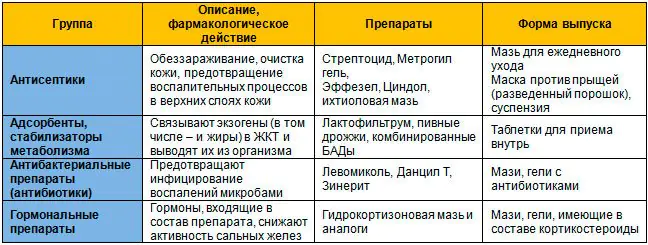
All these products should be used with caution, with mandatory testing on a small area of skin. Despite the fact that many ointments and gels are supported by vitamin complexes and special nutrition for the skin, during the treatment period much attention should be paid to daily facial care. Oily skin does not mean moisturized. Suspensions and creams can dry out the skin, peeling and itching can become an additional factor in its irritation and infection. Regular disinfection kills not only pathogenic, but also the skin’s own protective flora, also making it vulnerable. All this should be taken into account when starting treatment with acne creams and ointments. Antibacterial and hormonal drugs should be used with particular caution, treatment of which should definitely be carried out under the supervision of a doctor and involves undergoing numerous tests. It should also be remembered that acne leaves pigmentation on the skin, which, although it goes away over time, also requires additional attention. Cosmetology will also help speed up the depigmentation process - whitening clay masks, creams with high UV factors that protect against solar pigmentation. It is impossible to remove atrophic scars with pharmacological means - this problem can only be solved in beauty salons with laser resurfacing and other means of hardware cosmetology.
Determining the causes of acne on the face
Getting rid of acne will be truly effective only if it is under the supervision of a specialist. Even a mild form of the disease, if prolonged, indicates problems with hormonal levels or with the functioning of internal organs. Therefore, it is best to consult not only a cosmetologist, but also an endocrinologist, who will prescribe the necessary tests, select the right diet, and determine the optimal treatment strategy and tactics. Contrary to popular belief, this is a shorter and less expensive way than constantly thoughtlessly changing jars and tubes in the hope of “maybe.” Any treatment begins with laboratory and hardware diagnostics, which can be quickly and comfortably carried out in the INVITRO network of modern laboratories. They are located in almost all districts of Moscow.



